Why do we need to rebuild homes?
The issue here is not so much homes as the infrastructure of the cities. The rebuilding of homes comes from the need to restructure the infrastructure of the cities, which are not designed to handle growth. Without an eco-friendly design, as the cities grow, they will expand haphazardly and without much forethought into the impact on the environment. This is to be avoided. By restructuring the city, this unorganized expansion can be prevented. In addition to this factor, as the city grows, some people will grow wealthy. These people will want to buy luxuries such as air conditioners, which tend to waste energy. If homes are eco-friendly, then they will have no need for certain luxuries, such as air conditioners. Finally, an eco-friendly
village will foster ecological awareness in its residents. Because homes will be destroyed in the process of moving roads and other parts of the infrastructure, these homes will have to be rebuilt. These new homes will be both eco-friendly and comfortable.
[top]
Cooling
What: Cooling will be passive, utilizing a combination of green roofs (described under the “roof” section), shading, cross-ventilation, and evaporative cooling.
Why: Currently, it is not uncommon for residences to have either air-conditioners or refrigerators. The average home in the Galapagos will have one ventilator (300W) and one refrigerator (200W), each operated for about 8 hours per day (http://galapagos.solarquest.com/documents/SandiaGalapagosReport200307.pdf). If the need for active cooling were eliminated, then there would be no need for air-conditioners.
There are many forms of passive cooling that exist. Perhaps the most conventional method of cooling a house passively is through cross-ventilation. In order to do this, windows of relatively equal surface area must be located on opposite sides of the house. As air flows in one side of the house, it will flow across the house, and exit through the other side. An open house layout is required for such a design, such that the air can have the most unimpeded path possible. Such a layout can also create a more comfortable house by improving efficiency of movement and by allowing natural light to pass deeper into the house. Additionally, for cross-ventilation to work effectively, the house should be oriented such that large openings are found on the sides of the house that run perpendicularly to prevailing winds. Another factor, however, is the sun angle. The house should be oriented with its smaller faces on the east and west sides of the house. This way, when the sun is rising or setting, there will be little heat gain into the house. The sunlight factor creates the need for a balance between window openings and surface areas of sun-facing sides such that the house can maintain the coolest possible temperature.
Another method of passive cooling that could work in the Galapagos is evaporative cooling. This works in dry climates, like that of the Galapagos. One type of evaporative cooling involves a fan that draws air into the house through a damp surface, evaporating water in the process and cooling the house off significantly. Another type of evaporative cooling consists of an indoor pool of water that slowly evaporates, cooling the house. Also, since winds are never guaranteed, an evaporative cooler will keep the house cool even when cross-ventilation does not work.
Temperature Delivered by Evaporative Cooler
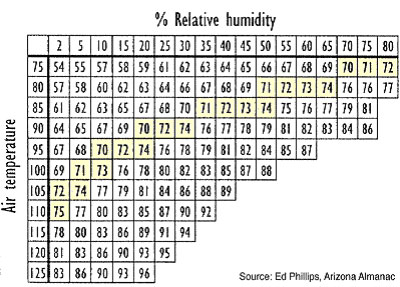 (http://energyoutlet.com/res/cooling/evap_coolers/)
[top]
(http://energyoutlet.com/res/cooling/evap_coolers/)
[top]
Insulation
What: No insulation at all.
Why: Insulation will most likely be unnecessary. Insulation is only really necessary when the difference in air temperatures between night and day are significant. In the Galapagos, temperatures generally vary about 7 degrees Celsius between night and day. If the temperature were to drop off significantly at night, then insulation might be necessary to keep the heat in, but such is not the case. The other situation in which insulation might be preferable would be if air conditioning were used, because in this situation, it is most energy efficient to keep the heat out of the house. In the case the eco-friendly houses, which will use evaporative cooling in addition to cross-ventilation, the house will be open during the day anyway (evaporative cooling requires that the house be open during the day for it to work properly). Thus, insulation would do little or no good.
If insulation ever became necessary, it would be relatively simply to bring in pneumatic blowers to install insulation made from recycled newspapers.
[top]
Foundations
What: Foundations will be constructed of concrete, made from recycled concrete aggregate and fly ash cement.
Why: Fly ash is a recycled product derived from the waste gases from power plants. A glasslike powder, it is environmentally friendly and nontoxic. In addition to this, it uses less water, so it is less likely to crack (
http://www.toolbase.org/tertiaryT.asp?DocumentID=2072&CategoryID=1402). Fly ash cement is a viable alternative to Portland cement. By using fly ash cement, fewer virgin materials will be used, and these recycled materials are environmentally friendly as well.
Given that the houses in the Galapagos are currently made of large concrete blocks, it would be wasteful not to use the materials we have. The aggregate made from the old concrete will not be enough to build the new houses, but this turns out to fit our plan to make adobe houses beautifully. The foundation need only extend 4 to 6 inches above the ground, to protect the adobe from groundwater.
We realize that dust and debris from concrete demolition is a concern for the environment. It is therefore necessary to take precautions to keep dust clouds from forming over the building sites. We will also need to make sure that houses near constructions are properly sealed and ventilated, so that nobody’s health is adversely affected. This can be accomplished through relatively simple safety practices. Most obviously, all the residents near the demolition or construction site will be informed of exactly what will take place each day, so that they will be prepared for any noise or debris. A simple plastic tenting is a very effective way to keep dust out of the air, as is moistening the ground around the demolition site before beginning work. However, we are not expecting dust to be a significant problem because the houses are constructed of blocks, not coherent structures. They can be easily lifted apart.
In order to mix the new concrete on site, a diesel-powered mixer truck must be used. We suggest the use of Enviroguard’s system, because it reuses the wash water needed to clean out the cement mixer in the concrete. This water has a very high pH and would be dangerous to the environment if it were to leak out.
Although diesel is not an ideal fuel, during the transition period from diesel to wind power there will be quite a bit of excess diesel on the islands for use. San Cristobal has a holding tank of approximately 55,000 gallons, for example, not all of which will be needed once the wind generators are working.
[top]
Walls
What: On top of the foundation, an adobe brick structure will be constructed. The walls will be thick. This varies with the building material. They may be as thick as 1-2 feet.
Why: Naturally, thicker, heavier walls, like those of adobe, have a greater capacity to absorb heat (they act as heat sinks). During the day, they absorb heat from the sun, and at night, they release it. Another option for the walls is stacks of rugs bound together into bales. These recycled rugs are a good insulator, and also serve to keep the elements out.
Adobe Bricks
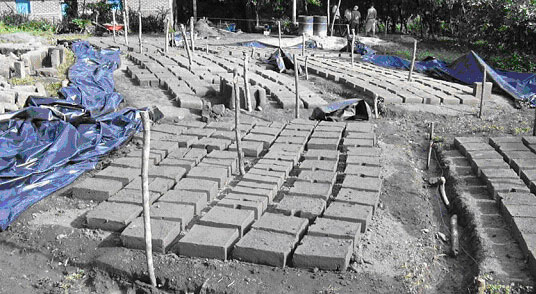 (http://www.cv.ic.ac.uk/el_salvador/)
(http://www.cv.ic.ac.uk/el_salvador/)
Adobe has a number of wonderful characteristics. Anybody can learn to make the bricks in a wooden mold, and training moves quickly. While it is important that the right mix of constituents be attained for structural stability (80% sand, 20% clay), adobe is a forgiving medium. If a mistake is made, it takes virtually no effort to remake the brick in question or rebuild a section of wall. There is also a grace period between when the bricks are set and when they dry, so if mistakes are found within that time they can be corrected.
Adobe building has a reputation for being labor intensive, and in a sense, this is true. However, in our situation this is actually a good thing. Since we are looking to draw attention away from the tourist sector in order to discourage rising visitor numbers, it makes sense to offer a high salary to a large group of adobe builders. These builders would feel a personal connection and investment in the village project. Since adobe buildings, while wonderfully stable (some of the oldest American buildings are adobe mission churches) also need repairs, it will be prudent to have such a trained task force available to mix adobe and patch walls once the initial construction is done.
Adobe may be labor intensive, but in terms of damage to the environment, it does worlds better than other materials, such as concrete. One estimate is that a block of concrete consumes 30,000 BTUs of energy during manufacturing, while an adobe block of comparable size uses only 2,000 BTUs. The building materials are also cheap. Since an adobe brick is comprised primarily of sand, something that is abundant and not endangered on the Galapagos, the cost may be as low as 50 US cents per brick.
Lastly, adobe houses eliminate the need for materials like strandboard or drywall that typically contain formaldehyde. There is no need to worry about long-term chemical damage to the soil.
Other materials that might have been used for the houses are wood, concrete, strandboard, and steel. Wood, while plentiful and available in the form of invasive species on the Galapagos, would not be a prudent choice. Even if the amount of wood were sufficient, it would be nearly impossible to regulate the deforestation of enough to build a village without making mistakes and harming endemic species. Concrete, while a good heat sink, requires more machinery and training to use. In addition, none of the raw materials can come from the Galapagos. We are taking advantage of concrete’s properties by using it for the foundation. Strandboard can be made out of 100% recycled materials, but using it in construction would mean a massive training program in building frame houses, something that is counter to the existing culture on the Galapagos and which is outside our time frame. It also requires much more machinery manipulate than adobe. Lastly, steel, while wonderfully recyclable, would clash horribly with the native style of architecture, something that we feel would greatly endanger the success of the project.
[top]
Floors
What: Formaldehyde-free bamboo flooring supplied by Bamboo Hardwoods (Distributor: Mari Strain, Berkeley, CA (510-548-4914) Website: www.bamboohardwoods.com)
Why: Bamboo has minimal impact on the environment. It re-grows in about three and a half to seven years compared to the 120 years it takes Oak Trees to re-grow. It also produces twice as much fiber as does a pine tree. Using Bamboo reduces the need to use virgin lumber, which reduces the need to harvest lumber using clear cut methods. Bamboo is easy to maintain and it is attractive. It comes in a variety of pre-finished colors such as natural, amber and cherry, and it also accepts stains, making it easy to blend and match to other colors. Bamboo is also very strong. Tests have been done that show that it resists dents to a ball being dropped better than oak resists dents and that it is as hard as maple wood. This type of flooring helps to control erosion because the rhizome web keeps riverbanks from falling wearing down. Bamboo flooring can easily be installed by nailing or gluing it down.
Why this is Better: Another type of flooring that could be used is cork flooring. However, this choice is not as good as bamboo because cork is damaging to the environment. When the trees are stripped of their cork, they are more susceptible to environmental damage. A second type other than bamboo flooring is natural linoleum. This is good because there are no pollutants associated with it and that is lasts a long time. However, it produces “off gas” that can be harmful and it cannot be exposed to constant moisture. Since it cannot be exposed to constant moisture, this type of flooring would not be a good choice for the Galapagos communities because they are located along the water.
[top]
Paint
What: Milk Paint (for the interior from the Old-Fashioned Milk Paint Company; Phone Number: 978-448-6336; Website: www.milkpaint.com)
Why: This organic paint is milk-based, has natural pigments, and all of the ingredients can be used in food and pharmaceuticals. It is safe for people and the environment since all of the ingredients are edible and biodegradable. This paint is free of solvents, harmful poisons, strong odor, volatile organic compounds, and harmful air pollutants. It is antibacterial and non-flammable and dries quickly. This paint can be used on cabinets, floors, furniture, walls, and woodwork. It penetrates porous surfaces well.
Why this is Better: Milk paint is the best choice for interior paint because it is the only paint that does not contain any VOC’s. Other companies such as Benjamin Moore, Glidden, Kelly Moore, and Sherwin Williams make paints that have low VOC levels but no VOC levels is better than low. There is one company, American Formulating Manufacturing, which makes formaldehyde free paints. However, this can only be used for wood and cannot be applied in direct sunlight. Milk paint is more versatile and does not need to only be used on wood. Also, the Galapagos Islands is a sunny environment and the application of the product from American Formulating Manufacturing would be difficult to apply.
[top]
Roofs
What: Roofs will be green roofs.
Why: Green roofs are essentially gardens on roofs. They can consist of any number of types of plants, which grown in several inches of pumice rock on top of a protective, water-proof layer. (In the case of the Galapagos, these plants would be native species, as importing species to the Galapagos causes ecological problems as has already been seen. Native species would grow well on the roofs anyway, since they are used to the Galapagos climate.) Excess rain water is collected. A small pump run by a solar panel waters the garden with this water.
It would be ideal to grow endemic marshy grasses on the green roofs so that salt water could be tolerated as irrigation in the absence of rain. However, since this has, to the best of our knowledge, never been tried, and endemic Galapagos grasses are obviously unavailable to us in Cambridge, we cannot make direct recommendations for species. However, a list of grasses can be found here, http://herb140.bio.au.dk/botany/PersonalPages/SimonLaegaard/GRASSES.pdf, and during the first year of construction tests, we would need to find out which species are best suited for the green roofs.
A Green Roof
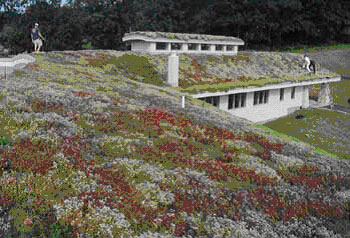 (http://newfarm.org/depts/talking_shop/0204/CASA2.shtml)
(http://newfarm.org/depts/talking_shop/0204/CASA2.shtml)
Green roofs are another method of passive cooling. These roofs reduce cooling costs drastically by acting as an insulating layer. Compared to a house with a non-green roof, homes with green roofs have relatively constant interior temperatures, due to this insulating factor. According to a study done by the National Research Council Canada, Ottawa, shows dramatic differences in the membrane temperatures of conventional roofs and green roofs. Whereas the conventional roof reached a temperature of 70 degrees Celsius, the green roof stayed around 25 degrees Celsius.
Green Roof Membrane Temperature
 Green Roof Thermal Energy Demand
Green Roof Thermal Energy Demand
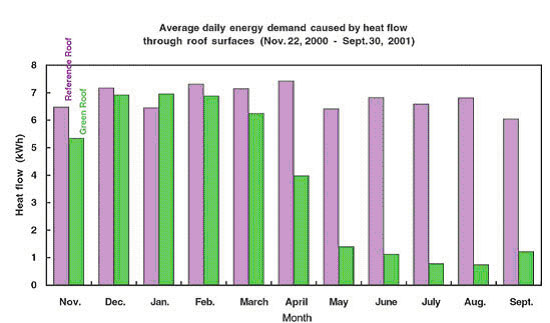 (http://www.professionalroofing.net/article.aspx?A_ID=130)
(http://www.professionalroofing.net/article.aspx?A_ID=130)
Plants naturally filter pollutants from the air. Also, because much of the rainwater that falls on the roof is retained, heavy metals in the water, such as zinc, cadmium, lead, and copper, become bound to the soil instead of washing away into storm drains. (
http://www.greenroofs.com/Greenroofs101/ecological.htm).
Green Roof Structure
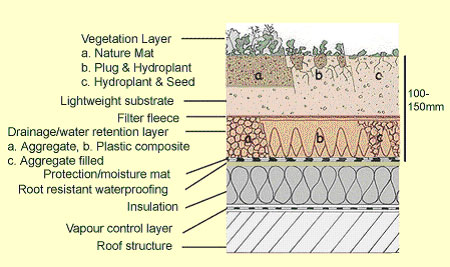 (http://www.greenroof.co.uk/html/main3.htm)
(http://www.greenroof.co.uk/html/main3.htm)
Green roofs significantly reduce runoff quantities. A Pennsylvania State University study from 2003 found that green roofs can retain up to 47.29% of water that falls on the roof (
http://hortweb.cas.psu.edu/research/greenroofcenter/research.html). This is especially important when working with adobe, a moisture-sensitive material.
Another advantage of this type of roof is that it reduces noise inside the house by muffling sounds from the outside. They also have a long life-span, increasing the lifespan of roofs by about 3 times.
[top]
Windows
What: Large enough to let light in, but not so large that an undue amount of heat is let in.
Why: Cross-ventilation is necessary, so windows of equal surface area should be found on two opposite sides of the house. If they swing outward with an upper hinge, a space should be located in between the hinge and the wall of the house, so that air flows along the floor inside the house instead of along the ceiling. This type of air flow is more comfortable. Windows can be of basically any type, from casement to double-hung. Whatever the case may be, these windows should not be located in direct sunlight so as to prevent the greenhouse effect from occurring within the house. They should also be able to open and close, depending on the weather.
The idea of “super-windows” was presented. This type of window uses two layers of glass with a gas layer in between them, which acts as an insulator. As the Galapagos do not have a very large temperature range and conventional insulation is not necessary, however, these windows are most likely unnecessary, and would be an inefficient use of money.
[top]
Lighting
What: Compact Fluorescent Lighting (from GE Lighting (1-800-626-2004), Lights of America (1-909-594-7883), Link USA (1-800-224-4228), MaxLite SK America, Inc (1-800-555-5629), Panasonic Lighting (1-201-348-5381), and ProLight (1-800-968-2556)
Why: The quality of lighting is the same quality that the incandescent lighting provides but it saves from 50-80% of the energy costs. This light bulb lasts eight to ten times as long as an incandescent light bulb. It is also about three to four times more efficient than incandescent bulbs.
Why this is Better: Compact fluorescent lighting is much better than using incandescent lighting. It can save consumers 50-80% of energy costs and it lasts eight to ten times longer. Compact Fluorescent Lighting is three to four times more efficient than incandescent lighting. As a result of the higher efficiency, less carbon dioxide is released into the atmosphere. This is because it takes less energy to run a compact fluorescent light bulb than in does to run an incandescent light bulb for the same amount of time. About 2.5 pounds of carbon dioxide is released to generate one kilowatt-hour of energy so since the compact fluorescent light bulb can produce this energy for a longer time, it will release less carbon dioxide.
[top]
Paper: Towels and Tissue
What: Green Seal approved bathroom tissue products (from Javitis-Wagner- O’Day Program c/o National Industries for the Blind (1-800-433-2304; website: http://www.jwod.com) or from Bay West Paper (1-877-907-2737; website: http://www.baywestpaper.com)
Why: The Paper Towel, C-fold produced by Javitis Wagner-O’Day Program c/o National Industries for the Blind is 100% recycled and is 90% post consumer recycled. The bleaching process is chlorine free and the paper towels, along with their packaging, is free of toxins.
The EcoSoft Green Seal Bathroom Tissue by Bay West Paper is 100% recycled and is 49% post consumer recycled. The bleaching process is chlorine free and the tissue along with its packaging is free of toxins.
Why this is Better: Other possible tissue manufacturers include Marcal Paper Mills, Cascades Tissue Group, Earth Friendly Products, and Kimberly-Clark Worldwide, Inc. These companies are inferior to Bay West Paper and to Javitis Wagner-O’Day Program c/o National Industries for the Blind because they do not sell products that are certified to Green Seal’s environmental standards. The Green Seal certification requires that packaging be free of toxins (including lead, mercury, and cadmium). The products that are certified by Green Seal are much better for the environment than products that are not certified by the Green Seal.
[top]
Cleaning Solutions
What: Eco friendly Cleaners (vinegar, baking soda, corn starch, salt, borax, lemon juice, olive oil, mild liquid soap, reusable steel wool that do not contain toxic cleaners, and non-chlorine scouring powder.
- All-purpose cleaner:
- 2 Tablespoons of baking soda
- 1 pint warm water
- Lemon juice or vinegar to cut the grease
- Surface cleaner:
- 1-quart hot water
- 1-teaspoon oil based soap or vegetable oil-based detergent
- 1-teaspoon borax (acts as a water softener)
- Vinegar to cut the grease
- Surface cleaner 2:
- ½ cup vinegar
- 1-quart warm water
- Surface cleaner 3:
- Dissolve baking soda in hot water
- Scrubbing paste:
- Window cleaner:
- ¼ cup white vinegar
- 1-tablespoon cornstarch
- 1-quart warm water
- Oven Cleaner:
- 1 part vinegar to 4 parts water
Why: Eco friendly cleaners are less polluting to make, less likely to hurt someone if they are ingested and do not pollute indoor air. These eco friendly cleaners are less expensive and will not harm the environment after they are used.
Why this is Better: The combination of cleaners listed above is much better for the environment than cleaners that are usually used such as: Lysol, Windex and Pine Sol. They are also much less expensive than the commercial name brand products and are much less polluting to manufacture.
[top]
General Idea of Layout for Common Houses
This is a very basic outline of facilities that should exist in the common houses and their relations to each other. They should follow the same construction concepts of the houses (outlined above). The common houses should serve as a form of unification for housing communities. They should serve as a social center and boost the sense of community.
First of all, cooking facilities should exist, either of a communal type, or in the form of a restaurant/cafeteria, depending on what the residents want. A large dining area should exist near the kitchen. In addition to an indoor dining area, an outdoor patio/dining area should be built; as such an area will be comfortable in a dry area like the Galapagos, especially in the evening.
Provided that the residents are enthusiastic, we would like to provide a market place in each common house. This would be an ideal outlet for local farmers. Currently, food purchased from the mainland is cheaper then local food, something we need to reverse to encourage self-sufficiency. The common house kitchen would have access to this market, but it would be open to all residents for any private use.
Other social areas should be found around the dining area. Perhaps a library should be located near the dining area, assuming that this would be a valued part of the common house. Nothing will be definite until these common house proposals are discussed with current residents. Perhaps a daycare center should be included in the common house as well. A Laundromat and perhaps a small convenience store could be constructed unobtrusively in the common house as well. Outdoor facilities could include a playground, and possibly a sports field. None of these options, however, is definite until designers talk with current residents about the housing options that will be available.
[top]
Sources
- An Assessment of Energy and Water in the Galápagos Islands. http://galapagos.solarquest.com/documents/SandiaGalapagosReport200307.pdf. Visted: 11/27/04.
- “Ecological.” http://www.greenroofs.com/Greenroofs101/ecological.htm. greenroofs.com, 2004. Visted: 11/26/04.
- “Evaporative Coolers: An energy-saving way to beat the heat.” Evaporative Coolers. http://energyoutlet.com/res/cooling/evap_coolers/. Energy Outlet, 1999. Visited: 11/24/04.
- “Fly Ash Concrete.” http://www.toolbase.org/tertiaryT.asp?DocumentID=2072&CategoryID=1402. NAHB Research Center, 2001-2004. Visited: 11/24/04.).
- “GREEN ROOFS.” http://www.greenroof.co.uk/html/main3.htm. Blackdown Horticultural Consultants Limited, 2003. Visited: 11/24/04.
- http://hortweb.cas.psu.edu/research/greenroofcenter/research.html. Penn State Center for Green Roof Research, 2004. Visited 11/27/04.
- http://www.cv.ic.ac.uk/el_salvador/Design/Assets/Colour%20Photos/pages/05%20Adobe%20Factory_jpeg.htm. Visited: 11/27/04.
- Liu, Karen, Ph.D. “Going Green.” http://www.professionalroofing.net/article.aspx?A_ID=130. National Roofing Contractors Association, 2004. Visited: 11/24/04.
- “Stars of the Chesapeake.” http://newfarm.org/depts/talking_shop/0204/CASA2.shtml. The Rodale Institute, 2004. Visited: 11/27/04.
- “Galapagos Grasses and Sedges.” http://herb140.bio.au.dk/botany/PersonalPages/SimonLaegaard/GRASSES.pdf. S. Laegaard, 2002. Visited: 11/27/04
- “Your Portal to Adobe.” http://www.adobebuilder.com/ Adobebuilder.com, 2001-2004. Visited 11/20/04
- “Adobe Home Construction.” http://www.txses.org/epsea/adobe.html El Paso Solar Energy Association. Visited 11/21/04
- “Preservation of Historic Adobe Buildings.” http://www.oldhouseweb.com/stories/Detailed/216.shtml Old House Web, 1998-2004. Visited 11/24/04
- “Cob and Adobe Construction.” http://www.toolbase.org/tertiary_printT.asp?TrackID=&CategoryID=1402&DocumentID=2010 ToolBase Services, 2001-2004. Visited 11/24/04
- http://www.adobe-block.com/, Adobe International, Inc, 2002. Visited 11/24/04
- “Solutions for the Jobsite.” http://www.enviroguard.ca/environment.htm Enviroguard. Visited 11/27/04.
[top]
Copyright! All rights reserved.
Webmasters
 (http://energyoutlet.com/res/cooling/evap_coolers/)
(http://energyoutlet.com/res/cooling/evap_coolers/) (http://www.cv.ic.ac.uk/el_salvador/)
(http://www.cv.ic.ac.uk/el_salvador/) (http://newfarm.org/depts/talking_shop/0204/CASA2.shtml)
(http://newfarm.org/depts/talking_shop/0204/CASA2.shtml)
 (http://www.professionalroofing.net/article.aspx?A_ID=130)
(http://www.professionalroofing.net/article.aspx?A_ID=130) (http://www.greenroof.co.uk/html/main3.htm)
(http://www.greenroof.co.uk/html/main3.htm)